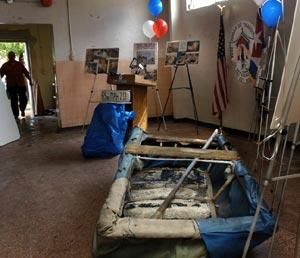Thu, Jul. 14, 2005
Museum honors voyages of exiles

Museum honors voyages of exiles

By LUISA YANEZ
Since Fidel Castro took power in 1959, more than one million Cubans have fled their homeland. Many didn't wait for visas. They simply jumped on homemade boats, rafts, inner tubes, even floating vintage cars, and took their chances at sea.
For years, attempts to tell and preserve the story of Cubans' never-ending flight to freedom via the Florida Straits has been just talk among exiles.
Now Arturo Cobo, a long-time activist who championed the cause of balseros in the mid-1990s, is setting out on an ambitious campaign.
Cobo on Wednesday unveiled a plan to open a museum in Little Havana to honor not only rafters but all Cubans' exodus by sea in the last 46 years, journeys that at times have ended in tragedy.
Among the remnants of such voyages to be displayed: Rudimentary rafts and inner tubes that people in the United States would not use in a pool, much less to cross an ocean.
It's all a testament to desperation, said Cobo, 64, who has saved, stored and displayed the vessels for years in the Keys.
''Our objective is to show the world the tragedy of our people,'' Cobo said at a news conference held at a now-closed Miami fire station in Little Havana -- the proposed future home of the Transit House Museum, or the Museo del Hogar de Transito.
The modest, one-story property at 141 NW 27th Ave. has been donated by the city of Miami, with the help of Commissioner Joe Sanchez, who looked in his district for a home for the museum.
But before the museum opens its doors, Cobo and his board of directors must raise $750,000 to renovate the building. The deadline is the first week of January 2006, as required by the city, which is giving the museum a 20-year license and a token $1 a year rent, said Jorge J. Del Valle, the museum's attorney.
Top on the list-to-do is to organize a massive fundraising campaign. Among the ideas in play are radiothons and telethons on Spanish-language media, plus a massive concert at the Orange Bowl to be dubbed ''Freedom Wave,'' which would borrow in spirit from the recent Live 8 concert.
''We are asking for everyone's help,'' said Cobo, who chose Wednesday, the 11th anniversary of the deadly sinking of the 13 de Marzo ferry, to make the announcement.
Among those who showed their support Wednesday were Miami-Dade Commissioner Rebeca Sosa, Miami Commissioner Tomás Regalado, radio personalities Tomás García Fusté and Martha Flores and one-time Miami-Dade mayoral candidate José Cancela.
''This museum will capture a moment in Cuban history that is filled with much happiness and sadness,'' said an emotional Sosa.
No official figures exist, but Cobo puts at 70,000 the number of Cubans swallowed by the sea. He said Castro has publicly admitted to about 45,000 casualties.
When completed, the museum will exhibit more than 10,000 photographs, many of dehydrated, sunburned Cubans near death and videos and testimonials from survivors.
Cobo, a former Bay of Pigs veteran, has dedicated the last 23 years to giving rafters a warm welcome at his once-popular, now-closed Transit House in Key West. Hundreds of thousands of Cubans have floated here; 125,000 alone during the 1980 Mariel boatlift. And they continue to attempt the voyage.
The stories of some balseros are heartbreaking, Cobo said. On Wednesday, he pointed to a photo of a Cuban rafter whose name he could not remember but whose story was too horrible to forget.
''This young man arrived totally traumatized. His father died of a heart attack on a boat. After three days at sea, the body started to smell, so they decided to drag it along in the water,'' he said.
A shark had other plans. ''They watched as his father's body was torn to shreds,'' Cobo said.
Cobo said a dramatic piece for the museum would be one of the three vintage cars rejiggered to float on water by the so-called ''truckonauts,'' two master mechanics who sailed them across the Florida Straits.
The missing cars are a 1948 Mercury, a 1959 Buick and a 1951 Chevy truck.
Reports are that all three were machine-gunned and sunk by the U.S. Coast Guard, which has not revealed their fate.
''We have asked every government official we can think of about the cars, but we've heard nothing,'' Cobo said. ``What better example to have in the museum than these cars?''